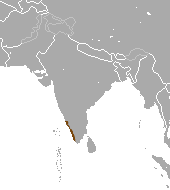Malabar large-spotted civet facts for kids
Quick facts for kids Malabar large-spotted civet |
|
|---|---|
 |
|
| Stuffed specimen at Government Museum, Chennai | |
| Conservation status | |
| Scientific classification | |
| Genus: |
Viverra
|
| Species: |
civettina
|
 |
|
| Malabar large-spotted civet range | |
The Malabar large-spotted civet (Viverra civettina), also known as the Malabar civet, is a rare animal found only in the Western Ghats of India. It is a type of viverrid, which is a family of small, cat-like mammals. This civet is in big trouble! It is listed as Critically Endangered on the IUCN Red List. This means there are fewer than 250 adult civets left in the wild. Sadly, no one has seen or recorded this animal in surveys done between 1990 and 2014.
In the early 1990s, a few groups of these civets were still living in parts of South Malabar. But even then, their homes were being destroyed, and they were hunted outside special protected areas. Local people in Kerala call it Kannan chandu or Male meru, and in Karnataka it's known as Mangala kutri, Bal kutri, or Dodda punugina.
Contents
What is the Malabar Civet?
The Malabar civet is a unique animal. Its scientific name, Viverra civettina, was given by Edward Blyth in 1862. Scientists have debated if it's a separate species or a type of Large-spotted civet. Today, the IUCN Red List considers it a distinct species.
How to Identify a Malabar Civet
The Malabar large-spotted civet has a dusky gray fur. It has a dark mark on its cheek and big, dark stripes across its back and sides. It also has two dark lines on its neck. These markings are darker than those on the large Indian civet. Its throat and neck are white.
A special feature is a mane (like a small furry crest) that starts between its shoulders. Its tail has dark rings, and its feet are dark. One way to tell it apart from the large-spotted civet is that the soles of its feet are more bare. There are also small bare spots on its back feet. An adult male civet from the 1930s was about 30 in (76 cm) long from head to body, with a 13 in (33 cm) tail, and weighed about 14.5 lb (6.6 kg).
Where Malabar Civets Live
In the 1800s, Malabar civets lived all along the Malabar coast of India, from Honnavar to Kanyakumari. They lived in forests and wooded lowlands, and sometimes in higher forest areas. They were once common in Travancore.
However, by the 1960s, many natural forests in the coastal Western Ghats were cut down. This caused the Malabar civet to become very rare, almost extinct. In 1987, one civet was seen in Kerala.
Later, in 1987 and 1990, a few civet skins were found near Nilambur in northern Kerala. This area now has many cashew and rubber plantations. These plantations might have been where the last civets lived, as they had thick bushes and grasses. But even these areas were being cleared for more rubber trees.
Surveys using camera traps were done in forests of Karnataka and Kerala from 2006 to 2007. Sadly, no Malabar civets were photographed, even after many nights of camera trapping. This shows how incredibly rare and hard to find they are.
Habits and Lifestyle
The Malabar civet is known to be a nocturnal animal, meaning it is active at night. It is also very shy and hard to spot. Because of this, scientists don't know much about its daily life or how it behaves in the wild.
Why Malabar Civets are in Danger
A few decades ago, some local traders in Kerala would raise Malabar civets. They did this to get a special substance called civetone from the civet's scent gland. This substance was used in medicine and perfumes.
Today, the biggest dangers to the Malabar civet are the destruction and breaking up of its habitat. Their forest homes are being cleared for farms and buildings. Also, hunting was a major threat in northern Kerala until the 1990s.
Mistaken Identity
During the COVID-19 pandemic lockdown in India, a video of a civet walking on empty streets in Meppayur went viral online. The person who uploaded the video thought it was a Malabar civet. However, many experts quickly identified the animal as a small Indian civet (Viverricula indica). The small Indian civet looks similar but is much more common than the critically endangered Malabar civet.


